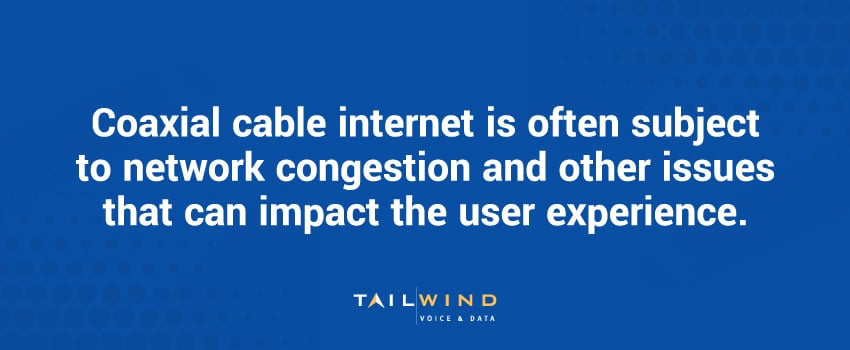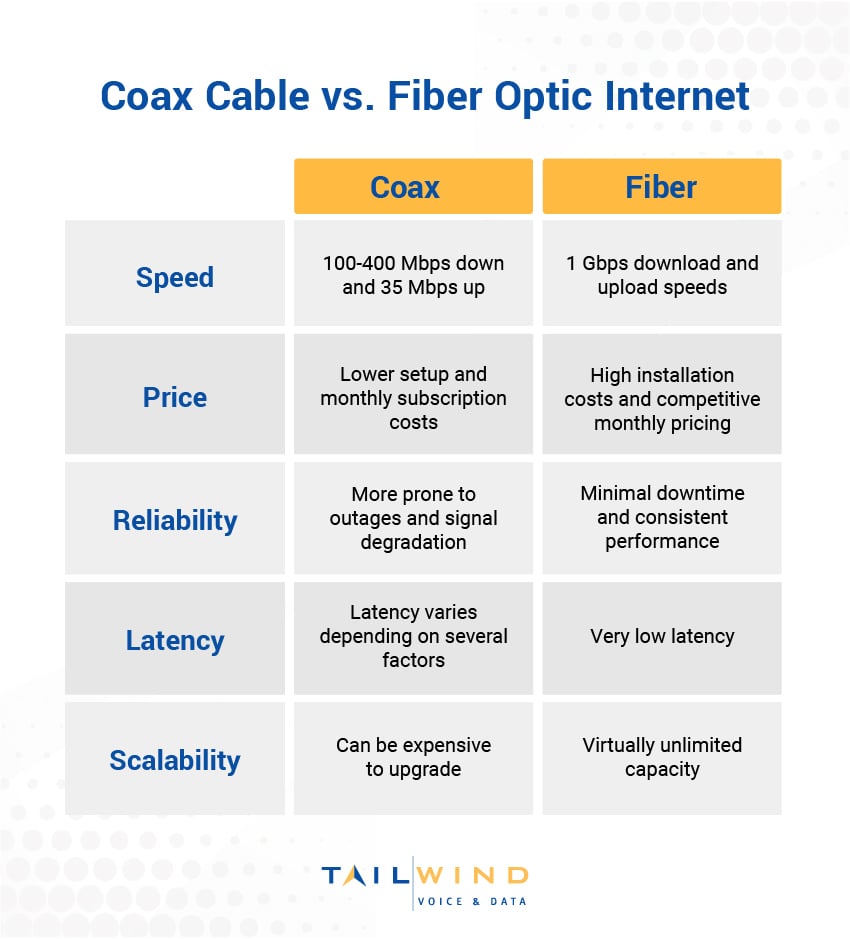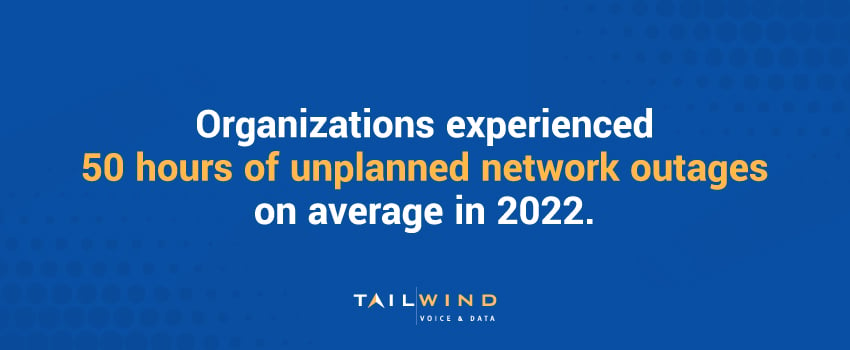When designing or upgrading a business network, two common options you'll encounter are coaxial cable and fiber optic connections. Both technologies have advantages and downsides, but while coax cable networks have long been considered the preferred choice for business internet, fiber internet is steadily gaining ground.
A 2022 study revealed that 43% of the U.S. population now has access to fiber internet, up 12% from 2021.1 But despite fiber's rising popularity, many organizations aren't sure whether it's the right fit for their connectivity needs. In this blog, we'll explain how coaxial and fiber optic networks work, their speed capabilities, and other factors to help you determine the best cabling infrastructure for your business.
What Is A Coaxial Cable?
Coaxial cables, often referred to as coax cables, are typically made of copper wire and use electricity to transmit data over long distances. For many years, coaxial cables were the primary method of bringing cable TV and internet access into homes and businesses. Though fiber optic cable networks are now taking over, coaxial cable is still a viable option for fast, reliable business internet at a budget-friendly price.
The Components Of A Coax Cable Network
Here are some of the components that make up a coax cable network:
How Coaxial Cables Work
At the center of any coaxial network are the coaxial cables themselves. These cables consist of a copper conductor wire surrounded by insulation, which is encased in a braided metal shielding. This shielding helps block radio frequency interference that could disrupt the signal.
The cables transport data by carrying an electrical signal through the copper core from the internet service provider (ISP) to your business, typically via a cable running underground or along telephone poles.
Cable Modem
Once the coaxial cable reaches your building, it's connected to a cable modem. The modem converts analog data from the cable line into digital data that computers and devices can use to connect to the internet.
Most modern cable modems now contain built-in routers that broadcast a WiFi network throughout the business for connecting devices wirelessly. Some service providers require you to rent their branded cable modem/router combo units.
Coaxial Backbone Connectivity
At the other end of coaxial lines, cable providers have infrastructure connecting to high-capacity fiber optic lines and networks that make up the internet backbone. Multiple coaxial cables extend outward into neighborhoods from centralized hubs, forming a tree-like topology.
In these hubs, servers handle tasks like user authentication, assigning IP addresses, routing data to and from the internet backbone, and balancing network loads. When an employee at your business requests a web page, the cable modem passes the request through the coaxial line to these servers.
Splitters & Amplifiers
The coaxial cable signal weakens the further it travels, so additional components are needed to maintain your connection. Splitters divide the cable connection into multiple output ports when reaching a neighborhood node. Amplifiers strengthen the signal at periodic intervals to ensure it maintains adequate power. Together, these devices allow a coaxial network to serve multiple businesses and homes in a geographic area effectively.
How Fast Are Coaxial Cable Speeds?
Since coaxial cable connections are typically shared among multiple subscribers, internet speeds can vary significantly. Depending on the quality of the cable, the infrastructure of the ISP, and the number of users connected to the same line, speeds can range from 10 Mbps to 1 Gbps on the higher end.
The actual data speed a user experiences can be lower due to network congestion during peak usage times, signal degradation over long distances, and the quality of their modem and router. Despite these factors, coaxial cable internet is generally faster and more reliable than DSL service. And while it doesn't match the potential speed of fiber optics, it does offer a cost-effective solution for fast internet in areas where fiber optic service isn't available.

What Is A Fiber Optic Cable?
Fiber optic cables transmit data as light waves through strands of glass or plastic fibers. As a result, these cables can carry more data over longer distances than copper cables, with less risk of degraded signal quality or electromagnetic interference.
The Components Of A Fiber Optic Cable Network
Some components that make up a fiber optic cable network include:
How Fiber Optic Cables Work
Each fiber optic cable consists of multiple tiny glass or plastic strands, thinner than a human hair, which transmit data encoded in light beams. Lasers in network equipment convert electrical signals into light pulses that bounce along the inside of the fibers. The core of the fiber is surrounded by a layer called cladding, which allows these light signals to move over long distances with minimal signal loss, even as the cable bends or twists.
Network Nodes
Fiber optic networks have centralized connection points called nodes, which contain networking equipment that switches and routes signals through the network. Fiber optic cables fan out in branching configurations from these nodes to neighborhoods and buildings.
At the neighborhood level, an optical splitter divides the fiber connection into multiple paths. Each fiber strand serves a single home or business to provide dedicated bandwidth. These fiber strands connect to an optical network terminal on your building's exterior.
Optical Network Terminal (ONT)
The optical network terminal (ONT) converts the light pulses into electrical signals that can be transmitted through the electrical wiring in a home or business. The ONT typically connects to a fiber modem/router combo device that broadcasts a WiFi network, allowing your wired and wireless devices to access the fast internet speeds delivered through the fiber optic connection.
Fiber Optic Backbone Connectivity
As with coaxial internet services, fiber optic internet providers have connections to major internet backbones with significantly more capacity. The enormous bandwidth capabilities of fiber allow millions of subscribers to simultaneously surf, stream, videoconference, and more at gigabit speeds.
How Fast Are Fiber Optic Cable Speeds?
Fiber optic internet can achieve nearly limitless speeds – as fast as the equipment transmitting the data can support. Currently, most providers offer plans with max fiber speeds of 500 Mbps to 1 Gbps. However, fiber connections can theoretically achieve speeds exceeding 100 Gbps.
Unlike coax cable internet, fiber optics offer symmetrical upload and download speeds since they don't suffer from the same bandwidth-sharing issues as coaxial cables. This makes them ideal for businesses that use a lot of data or rely on cloud computing services.
Is Fiber Optic More Secure Than Coaxial Cable?
When it comes to network security, fiber optic cables provide significant advantages over coaxial cables. Their unique transmission method and resistance to external threats make them the preferred choice for businesses handling sensitive data.
Harder To Hack
One of fiber optic’s biggest security advantages is that it transmits data as light pulses rather than electrical signals. Unlike coaxial cables, which can be tapped using relatively simple hardware without detection, fiber optic cables require specialized equipment to intercept. Even then, any tampering usually causes noticeable signal degradation, making unauthorized access extremely difficult.
Signal Leakage & Interference
Coaxial cables are susceptible to electromagnetic interference (EMI) and radio frequency interference (RFI), which can lead to signal leakage or disruptions. This makes them more vulnerable to eavesdropping. In contrast, fiber optic cables are completely immune to EMI, ensuring a cleaner and more secure transmission with no risk of external signal interference.
Physical Tampering
Fiber optic cables are typically installed underground or in secured locations, making physical access more difficult. Additionally, because fiber does not conduct electricity, it is immune to grounding issues, electrical surges, and intentional signal jamming—problems that can affect coaxial networks.
Data Protection
Many fiber networks are designed with built-in encryption and authentication protocols, adding an extra layer of security. While encryption can also be applied to coaxial transmissions, the risk of physical interception remains higher, making coaxial inherently less secure for highly sensitive data.
Why Fiber Optic Is The More Secure Choice
For businesses that prioritize cybersecurity and data protection, fiber optic networks offer superior defense against hacking, signal interception, and interference. Their resilience against signal leaks and physical vulnerabilities makes them the preferred choice for industries handling confidential information.

Coaxial Cables vs Fiber Optic Cables: Comparison
When selecting the best cable infrastructure for business internet, both coaxial and fiber optic cables have their unique benefits. Here's a breakdown of the main factors to consider for your business:
Speed
Fiber optic internet offers exponentially higher speeds than coaxial cable internet. Fiber can comfortably deliver symmetrical gigabit speeds (1 Gbps down and up) to your business.
The fastest speed coaxial cables can achieve is typically around 1 Gbps down and 35 Mbps up. However, you're likely to max out at 100-400 Mbps for your download speeds, depending on your provider.
Price
Fiber optic internet was once cost-prohibitive, but prices have come down significantly. Gigabit plans are now competitively priced with coaxial cable packages from major broadband providers. However, fiber installation costs are higher if your area lacks existing fiber optic cable infrastructure. Coaxial cable internet is more widely available, lowering setup costs in many regions.
Reliability
Last year, businesses experienced nearly 50 hours of unplanned network outages on average.2 And considering 60% of outages lead to losses of over $100,000,3 network reliability is more important than ever. Fiber internet ensures minimal downtime, so employees stay connected to the network and online tools without disruptions.
Coaxial cable internet is more prone to line noise, signal degradation over long distances, and performance issues during bad weather, which can result in slower speeds and connection dropouts that impact operations.
Latency
Latency refers to any delay or lag in getting a network response. Fiber optics offer very low latency thanks to the incredible speed at which the network operates. This is pivotal for bandwidth-intensive applications like video conferencing and live streaming.
Coaxial cable networks have higher innate latency that becomes more noticeable the more devices connect and demand bandwidth. Network congestion can lead to laggy connections, buffering, and other issues.
Scalability
Fiber optic infrastructure offers virtually unlimited bandwidth potential, whereas coaxial networks have capped shared bandwidth for subscribers in the same area. Adding customers to a coaxial network can degrade performance for existing users, and the aging copper cable infrastructure often requires expensive upgrades to scale capacity.

Coax vs Fiber: Which Is Better For Your Business?
While both coaxial cable and fiber optic networks are viable options for business internet, selecting the right option depends on your organization's specific needs and circumstances. Fiber internet offers superior speed, reliability, scalability, and lower latency, making it ideal for enterprises with heavy data usage or reliance on cloud services. However, it can be more expensive than coaxial cable internet, which remains a reliable and cost-effective option for many businesses. Assessing your business's requirements, budget, and growth plans when deciding between coaxial and fiber-optic internet is crucial for finding the best fit.
Whether you opt for coax or fiber-optic internet, keep in mind that your network is only as strong as its weakest wire. Messy, disorganized cabling can slow connectivity, stagnate your growth, and even cause downtime – but a structured cabling expert like TailWind can ensure your network foundation is solid.
Trust TailWind to provide:
- Complete accountability for your fiber optic or coax network installation projects, from cabling to ongoing support.
- Responsive on-site service from over 3,000 dispatch points located across the U.S. and Canada.
- Cabling services and solutions tailored to meet the unique connectivity needs of your organization.
- Point-to-point cabling services for your telecommunications room, equipment room, and beyond.
Whether you're upgrading to fiber internet, relocating branches, or adding new services to your network, TailWind is your trusted partner for enterprise structured cabling and IT support. Get in touch with our network experts today to learn more or get started.
Sources:


